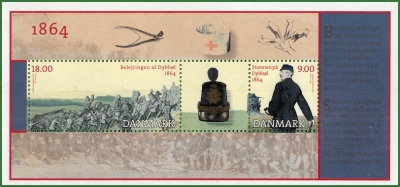-
Battle of Dybbøl 1864
Denmark 2014.03.15
In issue: Stamp(s): 1 Souvenir sheet(s): 1 Booklet(s): 1
Printing: multicoloral offset with engravings
Issued in: booklets of 5 stamps and like the souvenir sheet with 2 stamps and 1 label
-
Number by catalogue: Michel: 1775 Gibbons: 1746
Perforation type: 13 ¼x13 ½
Subject:
18 crowns. Prussian soldiers pulling a heavy cannon.
In the background can be seen a good silhouette Dybbøl windmill*.
Additional:
Booklets were printed on self-adhesive paper.
Topics: Mills within the landscapes Windmills
-
Number by catalogue: Michel: BL54
Perforation type: 13x12 ¾
Subject:
2 stamps of 18 crowns (with a common plot), with the label between stamps depicts military headgear Danish military.
The first stamp fully repeats the booklet one.
Additional:
The Battle of Dybbøl (Danish: Slaget ved Dybbøl; German: Erstürmung der Düppeler Schanzen) was the key battle of the Second Schleswig War, fought between Denmark and Prussia. The battle was fought on the morning of 18 April 1864, following a siege that began on 7 April. Denmark suffered a severe defeat which ultimately decided the outcome of the war.
On the morning of 18 April 1864 at Dybbøl, the Prussians moved into their positions at 2:00. At 10:00 Prussian artillery bombardment stopped and the Prussians charged; shelling from the Rolf Krake did not prove enough to halt them. Thirteen minutes after the charge, the infantry had already seized control of the first line of defense of the redoubts.
A total massacre of the retreating Danish troops was avoided and the Prussian advance halted by a counterattack by the 8th Brigade, until another Prussian attack threw them back; that attack advanced about 1 km and reached Dybbøl Mill. In that counterattack the 8th Brigade lost about half its men, dead or wounded or captured, allowing the remnants of the 1st and 3rd Brigades to escape to the pier opposite Sønderborg. At 13:30 the last resistance collapsed at the bridgehead in front of Sønderborg. After that there was an artillery duel across the Alssund.
During the battle around 3,600 Danes and 1,200 Prussians were either killed, wounded or missing. A Danish official army casualty list at the time said 671 dead; 987 wounded, of whom 473 were captured; 3,131 unwounded captured and/or deserters; total casualties 4,789. The 2nd and 22nd Regiments lost the most. Also, the crew of the Danish naval ship Rolf Krake suffered one dead, 10 wounded. 263 Prussians were killed during the battle.
The Battle of Dybbøl was the first battle monitored by delegates of the Red Cross: Louis Appia (1818-98) and Charles van de Velde (1818-98). Following the battle, the Prussians used the fort area as a starting point to attack Als in June 1864.On the field of Dybbøl there were formerly national symbols of both warring sides: the Danish Dybbøl Mill and the German Düppel Denkmal. Dybbøl Mill still stands, but the German victory monument was blown up in 1945. The perpetrators were never identified, and this monument has never been rebuilt.
_________
This information has been taken from Wikipedia
Size (of sheet, booklet) mm: 150x70
Topics: Mills within the landscapes Windmills




